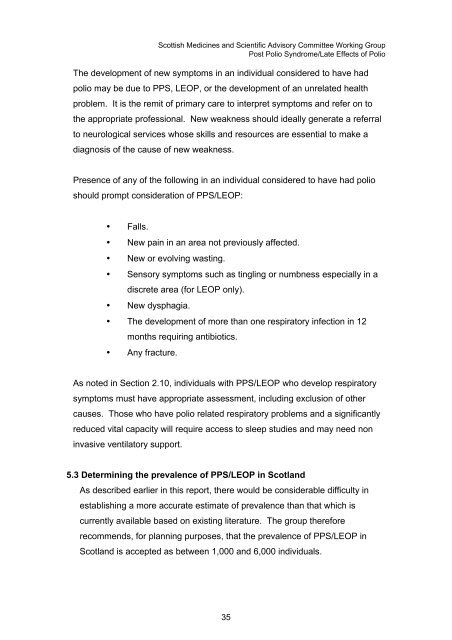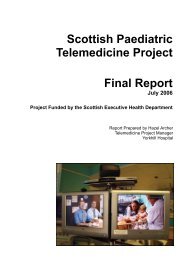SMASAC Working Group Post Polio Syndrome - Scottish Health On ...
SMASAC Working Group Post Polio Syndrome - Scottish Health On ...
SMASAC Working Group Post Polio Syndrome - Scottish Health On ...
Create successful ePaper yourself
Turn your PDF publications into a flip-book with our unique Google optimized e-Paper software.
<strong>Scottish</strong> Medicines and Scientific Advisory Committee <strong>Working</strong> <strong>Group</strong><br />
<strong>Post</strong> <strong>Polio</strong> <strong>Syndrome</strong>/Late Effects of <strong>Polio</strong><br />
The development of new symptoms in an individual considered to have had<br />
polio may be due to PPS, LEOP, or the development of an unrelated health<br />
problem. It is the remit of primary care to interpret symptoms and refer on to<br />
the appropriate professional. New weakness should ideally generate a referral<br />
to neurological services whose skills and resources are essential to make a<br />
diagnosis of the cause of new weakness.<br />
Presence of any of the following in an individual considered to have had polio<br />
should prompt consideration of PPS/LEOP:<br />
• Falls.<br />
• New pain in an area not previously affected.<br />
• New or evolving wasting.<br />
• Sensory symptoms such as tingling or numbness especially in a<br />
discrete area (for LEOP only).<br />
• New dysphagia.<br />
• The development of more than one respiratory infection in 12<br />
months requiring antibiotics.<br />
• Any fracture.<br />
As noted in Section 2.10, individuals with PPS/LEOP who develop respiratory<br />
symptoms must have appropriate assessment, including exclusion of other<br />
causes. Those who have polio related respiratory problems and a significantly<br />
reduced vital capacity will require access to sleep studies and may need non<br />
invasive ventilatory support.<br />
5.3 Determining the prevalence of PPS/LEOP in Scotland<br />
As described earlier in this report, there would be considerable difficulty in<br />
establishing a more accurate estimate of prevalence than that which is<br />
currently available based on existing literature. The group therefore<br />
recommends, for planning purposes, that the prevalence of PPS/LEOP in<br />
Scotland is accepted as between 1,000 and 6,000 individuals.<br />
35



